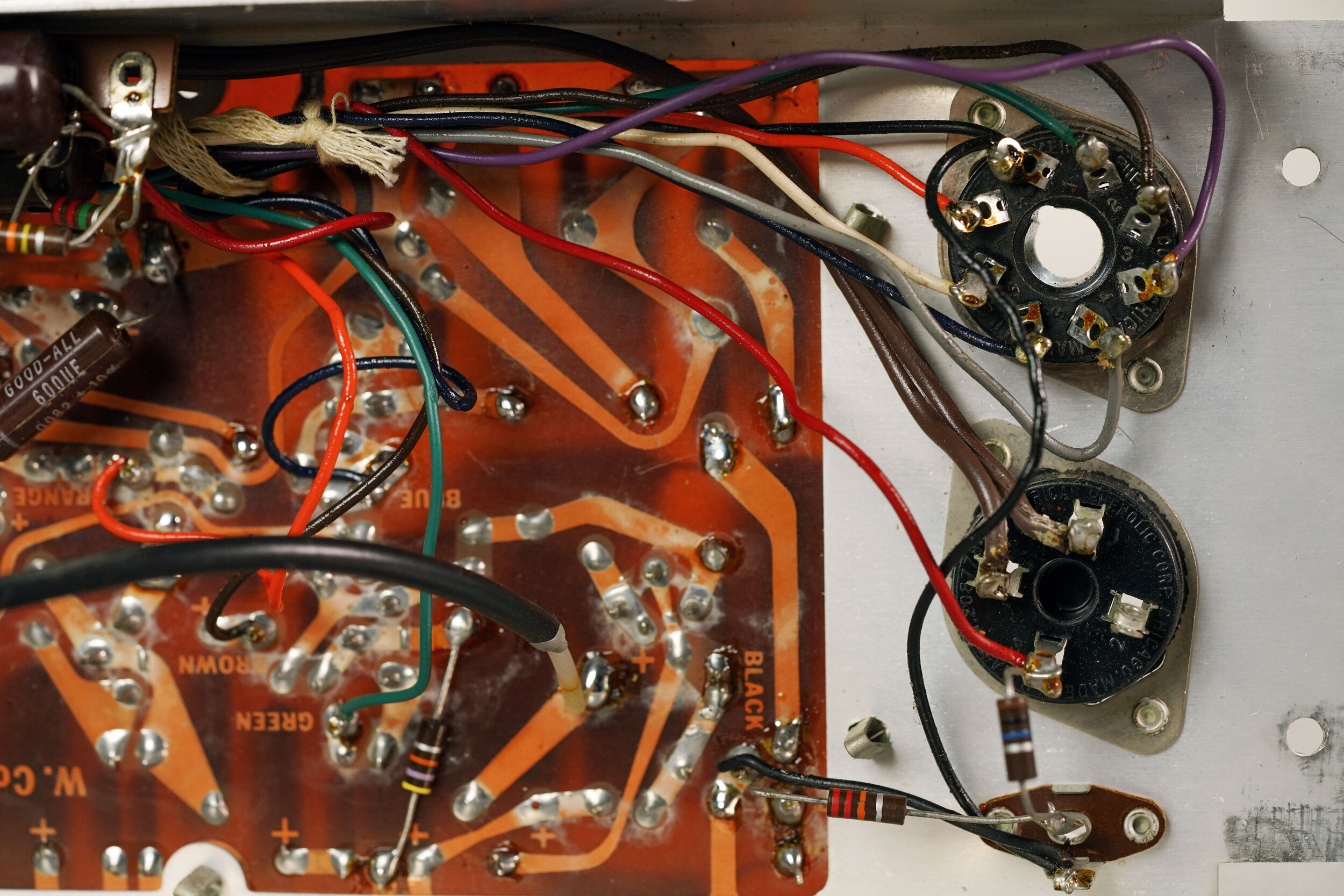Drawing the Line Between Troubleshooting an Amp and Modifying It
When you repair an amplifier, you have two choices. You can bring it back to its original state by fixing only what is broken. Or, you can improve the circuit by modding it.
There is a lot to love about an amplifier that is in fully-functioning, but original, condition. When using a vintage amp, you are playing music on a slice of time. You are combining two different musical periods in a way that is impossible to replicate with any other gear. It’s basically time travel.
How to Replace Wurlitzer 200 or 200a Metal Feet
If you have just scored a vintage Wurlitzer 200 or 200A, or perhaps you are just pulling one out of storage, you may find that the metal hardware has rusted or tarnished. Depending on where the Wurlitzer was stored, the chrome on the legs might have pitting and/or rust, and more than likely the feet have rust as well. In this article we are going to talk about how to replace the Wurlitzer feet. New Metal Wurlitzer feet are available in our shop and will be a closer match to the vintage chrome legs than the old dull feet. Also your studio floors will thank you!
Audio Recording at Home for Social Media
Whether you are a podcaster or a musician, capturing higher quality audio will make your content pop and grab your listener’s attention. That’s why graduating from apps and smartphones is something you have probably considered — and you would be right to do so. While the cameras on mobile devices are improving to a slight degree, their microphones are small and offer extremely poor sound quality. So, since we’ve decided you are going to aim for good sound quality, let’s go over the basics of how audio is recorded.
De-Rusting Rhodes & Wurlitzer Parts with Evapo-Rust
When restoring a Wurlitzer, there are a lot of really tedious and time-consuming steps: polishing keys, lubricating action parts, regulating, tuning, etc. We could go on and on — but we won’t, because today we are talking about rust removal, a task that is not on that list. Removing rust is easy and actually borderline fun because it only requires two things: a little Evapo-Rust and a few hours to kill while the product works its magic.
Checking and Changing the Fuse in Your Tube Amplifier
If your tube (or solid state) amplifier is not “turning on,” the cause of this problem could be a blown line fuse. The line fuse, also referred to as a mains fuse, is the fuse that stands between the main AC power and your power transformer. In an otherwise functional amp, the main fuse can and will blow when there is a problem between the wall outlet and your power transformer (PT). A fuse can also blow when there is a short somewhere in the amp. In either case, the fuse is doing its job when it blows and is protecting the amp by stopping it from running when there is a problem present that could harm the amp’s circuit.
How Vacuum Tubes Work
All tubes follow the same basic principles. Inside a tube’s glass enclosure, you have 1) a vacuum and 2) at least two electrodes (but often more, depending on what type of tube we’re talking about). Each electrode has a specific job: either releasing electrons, attracting electrons, or slowing down or speeding up the flow of electrons. We’ll talk about these jobs later. For now, the main thing that tubes are intended to direct electrical current from A to B in some way that is useful to the circuit.
What is the difference between a Wurlitzer 140 or 140b and a Wurlitzer 145?
The only true difference between 140-series and 145-series Wurlitzers is the amplifier. Both keyboards were released in the 1960s and represented a total redesign of the Wurlitzer electronic piano. Wurlitzer overhauled the mechanical action, revised the cabinet, and — for the first and only time — manufactured two parallel styles of amplifier: a solid state amp (the 140/140a/140b) and a tube amp (the 145).
Is it safe to troubleshoot my amplifier?
Tube amplifiers (and many solid state amplifiers) contain high voltages. Like any reasonably dangerous household object, you should certainly respect your tube amp. However, you don’t have to be afraid of it. If the amp is unplugged and the chassis is screwed in, it is safe to perform basic maintenance like replacing mains fuses and swapping tubes. In fact, fuses and tubes are accessible from the chassis because they are intended to be replaced by the user.
Common Tube Amp Malfunctions: My amp makes no sound.
If your amp makes no sound, it is first important to define what you mean by “no sound.” To that end, the first test you should perform is whether you can hear anything coming from the speakers. (This is, of course, after you have eliminated the possibility of trivial problems.)
Listening to what (if anything) comes out of the speakers can help you isolate the problem to specific parts of the circuit. If you hear no sound coming from the speakers — including hum, hiss, reverb crash, input cable pop, or any other incidental, non-musical sounds — the problem could be the speaker itself. But, if you hear non-audio sound coming from the speakers, the problem is likely, although not guaranteed, to be a fault in the preamp section of the circuit.
Common Tube Amp Malfunctions: How to accurately diagnose what is wrong with your vintage amplifier.
If your amplifier isn’t working, the best thing you can do is describe the problem as accurately as possible. If you’re into DIY, using accurate terms will help you google your problem and give you the best search results. If you’re asking a tech or a friend for help, describing your problem with specificity helps them offer more relevant suggestions.
Loved watching Billie Eilish and Finneas playing “Sunny” on a Wurlitzer 203? Here's a few more of our favorite live Wurlitzer videos
We loved Billie Eilish and Finneas’s performance of Sunny — and, of course, we always love seeing a console Wurlitzer out in the wild. It’s pretty rare to see them on stage. That’s because they aren’t as convenient as a Nord (or even a portable Wurlitzer), nor are they as visually dramatic as a conventional piano — but they have a full, rich tone with vintage character that rivals any other keyboard.
How to Troubleshoot Any Amplifier: Start with trivial problems.
The most efficient way to troubleshoot an amplifier is to investigate common trivial problems first. Complicated problems can have complicated solutions, but trivial problems can often be solved in a matter of minutes. By starting with potential trivial problems, you can cover a lot of ground quickly, without unsoldering a single connection. This reduces wear-and-tear on your amplifier, saves time, and prevents you from replacing components that still have plenty of life left in them.
On Cathode Bypass Capacitors
Cathode bypass capacitors are not absolutely necessary in a circuit. However, their presence or absence in an amplifier affects three things: gain, frequency response, and hum.
If you feel that your amp is lacking in any of these aspects, determining whether the cathodes are bypassed is a good place to start.
Book Sale! This Sunday, March 1
If you’ve been to our studio space you’ve seen our acoustic bookshelves, which are lined with custom acoustic baffles and stacked with books. They are part of the room’s sound treatment, and also provide a great video backdrop.
We’ve been accumulating books for years, so the shelves are getting pretty full - actually too full, because we’ve had to stop buying books for lack of a place to put them! So we’re having a book sale this Sunday, March 1, from 10am-2pm.
In Restoration: Rhodes Mk I
A customer brought this Rhodes in for restoration. It had been in storage for some time, and he asked us to bring it back to optimal playing condition.
The instrument was out of tune, missing most of its tolex, and suffered from a sloppy, unresponsive action. It had clearly been well-used for a while, and then at some point it had been put away and not used at all. Overall, though, it was in good shape, because all of its fundamental parts were present and more or less functional. That is, the wood parts weren’t warped, the plastic parts hadn’t deteriorated, and nearly every pickup worked. It was a great candidate for restoration.
From the Archives: Wurlitzer 206a
The 206a is the student-model Wurlitzer. It shares all the same cosmetic features of its professional counterparts, except - appropriate for the classroom - everything about it is just a little less exciting. Instead of dramatic black, here we have friendly beige. Instead of four speakers, we have two. Instead of vibrato, we have the self/ensemble knob.
On the Wurlitzer 120/700 Amplifier
This vintage tube amp was removed from a Wurlitzer 700 electronic piano. It’s is the same amplifier as a Wurlitzer 120…unfortunately. The 120 had very limited cabinet space, so that’s why the physical design of the amp is so cramped. On the other hand, the 700 had a cavernous cabinet that could definitely have handled a larger amp chassis. Oh well: that ship has obviously sailed.
Wurlitzer 120/700 Amplifier: Circuit Analysis
The Wurlitzer 120 amplifier represented a total redesign from the previous Wurlitzer model, the 112. The upside is that the amp is a lot smaller, so it fits nicely in the smaller, lighter 120 cabinet. The downside is also that the amp is a lot smaller. It’s missing many of the features that make the Wurlitzer 112 so magical. Regardless, it’s still a great vintage tube amp with a lovely, classic tone.
From the Archives: Wurlitzer 206 Student Electronic Pianos
These photos are from a batch of four student model Wurlitzers that we recently picked up. All arrived in amazing condition, with very few rips or scuffs and immaculately clean interiors. With just a little restoration, they became excellent and highly playable examples of early 200 Wurlitzers. Only one is still available.
How to Replace Vintage Filter Capacitor Cans
The filter capacitors in many amps are mounted in a metal can, which can be an obstacle to successfully recapping the amp. These days, filter cans are only made in a limited values, so it's hard to find the exact match. Mounting the caps outside of the can is another option, but finding the space can be tricky. Removing the can can leave a giant hole, which can allow dust to enter the chassis over time. So, what's the best way to replace can-style filter capacitors?




















